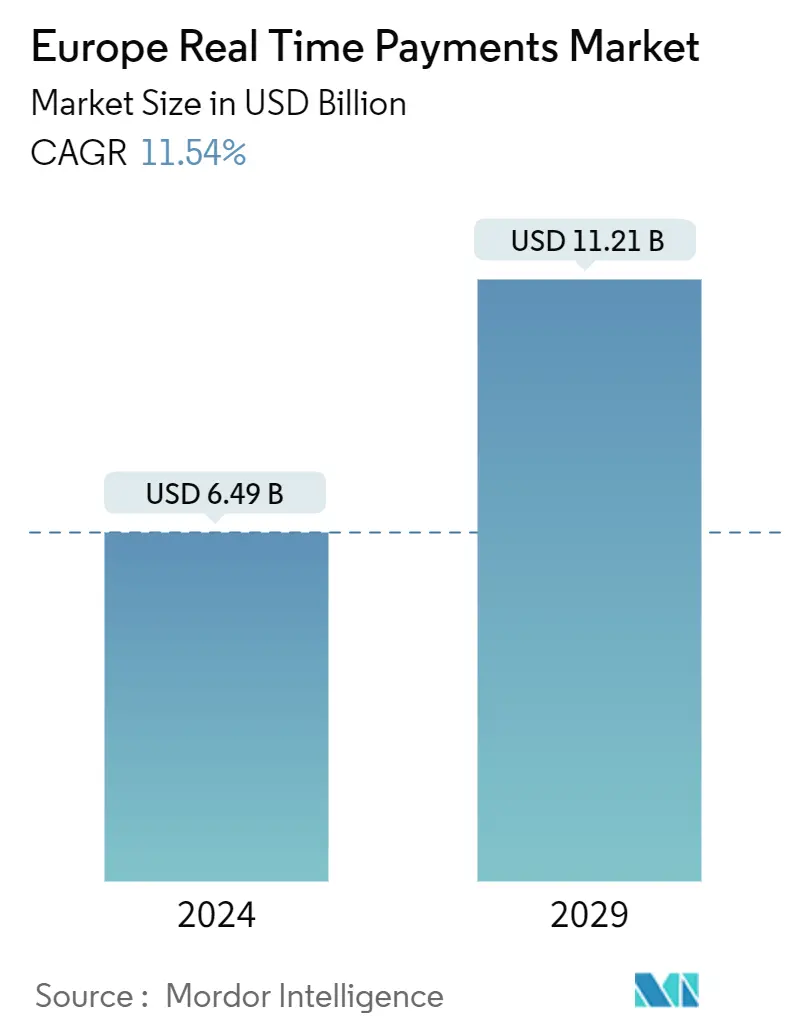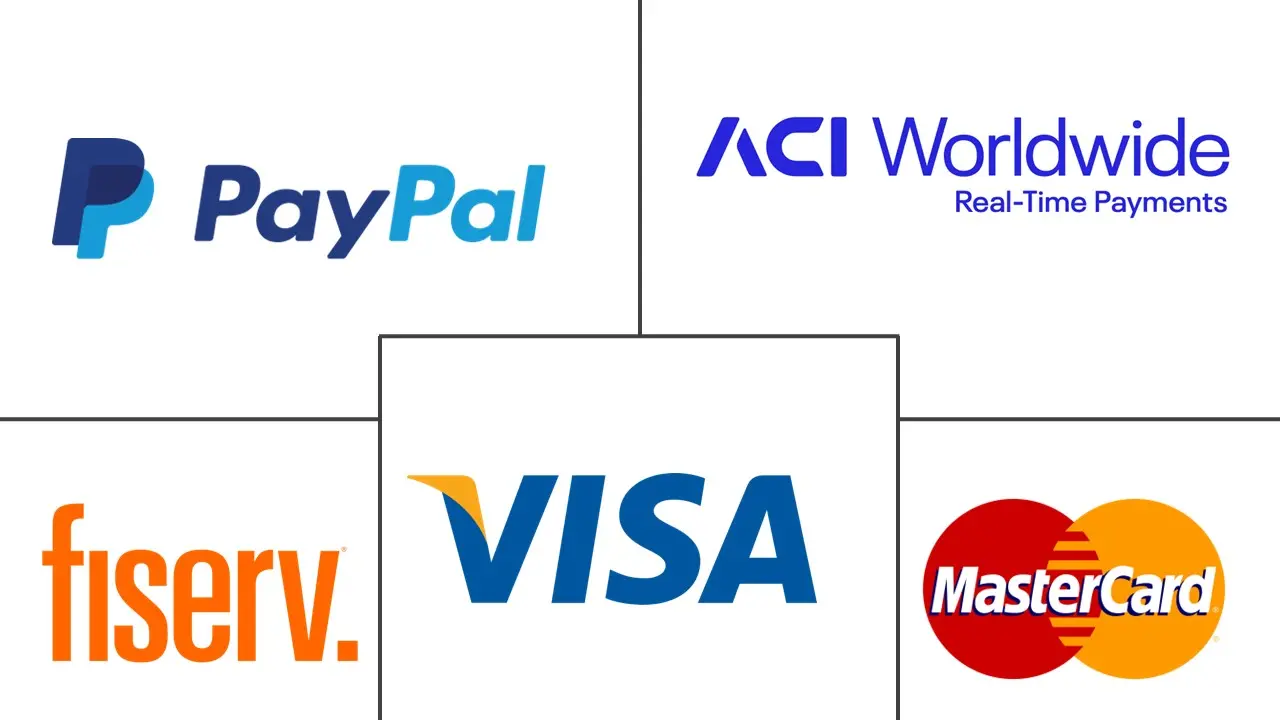Market Size of Europe Real Time Payments Industry

| Study Period | 2019 - 2029 |
| Base Year For Estimation | 2023 |
| Market Size (2024) | USD 6.49 Billion |
| Market Size (2029) | USD 11.21 Billion |
| CAGR (2024 - 2029) | 11.54 % |
| Market Concentration | Low |
Major Players
*Disclaimer: Major Players sorted in no particular order |
Europe Real Time Payments Market Analysis
The Europe Real Time Payments Market size is estimated at USD 6.49 billion in 2024, and is expected to reach USD 11.21 billion by 2029, growing at a CAGR of 11.54% during the forecast period (2024-2029).
The rapid proliferation of smartphones, consumers' need for quicker settlements, and government initiatives in the European region, among others, are the key reasons driving the market's growth.
- Increasing real-time payment adoption rates and continuous development and evolution of infrastructure across Europe indicate strong growth of real-time payments in the region in the coming years. Most European markets, including the UK and the Netherlands, experienced significant growth in volumes and values of real-time fund transfers; with the introduction of the P27 in the Nordic region, the real-time payment market is anticipated to grow.
- The European Payments Council (EPC) designed a pan-European instant payment system to accelerate the development of real-time payments in Europe. The SEPA Instant Credit Transfer (SCT Inst) process is based on the EPC's current SEPA credit transfer (SCT) scheme.
- Furthermore, this payment system enables euro credit transfers, with funds becoming available on the account in seconds at any time and in a region that will progressively expand to encompass 36 European countries. Several regional banking institutions are using SEPA Instant Credit Transfer (SCT inst.). Citi, for example, just implemented Single Euro Payments Area (SEPA) Instant Payments throughout Europe.
- Moreover, several initiatives based on ISO 20022 for real-time payments exist in Europe. In the United Kingdom, there is the New Payments Architecture (NPA), P27 in the Nordic region countries, SCT Inst. in Germany, and the EU is pushing on with the European Payments Initiative (EPI). These real-time payment systems will provide simpler access for increased participation, boost ongoing stability and resilience, and increase innovation through greater competition in the real-time payments market.
- Furthermore, the use of ISO 20022 is anticipated to improve cross-border and regional connectivity and enable additional data frames that can use to build new services. Furthermore, strong mobile and internet penetration in many countries of the EU, such as Sweden, Spain, Denmark, Poland, etc., is providing a strong platform for the growth of real-time payments in the region.
- However, growing payment frauds in real-time payments, such as Authorized Push payments, can hamper the growth of the real-time payments market in the region. With the 3D Secure 2.2 protocol and other SCA technologies to accommodate PSD2, card fraud in the region declined, but Authorized Push Payments frauds increased in the region.
- The COVID-19 pandemic enormously impacted how people shop and pay in the region. The new practices, including real-time and digital payments, are more convenient for customers and are likely to grow in the coming years.
Europe Real Time Payments Industry Segmentation
Real-time payments, also known as immediate, instant, or faster payments, guarantee the immediate availability of funds to the recipient. Real-time payments offer wide-ranging benefits for people, businesses, and society. Real-time payments facilitate better cash management and balance visibility and ease the move to electronic payments by offering a viable alternative to cash.
The European real time payments market is segmented by payment type (P2P, P2B) and country (UK, Germany, France, Italy, and the Rest of Europe). The market sizes and forecasts are provided in terms of value (USD) for all the above segments.
| By Type of Payment | |
| P2P | |
| P2B |
| By Country | |
| United Kingdom | |
| Germany | |
| France | |
| Italy | |
| Rest of Europe |
Europe Real Time Payments Market Size Summary
The Europe real-time payments market is poised for significant growth, driven by the increasing adoption of smartphones, the demand for faster transaction settlements, and supportive government initiatives across the region. The market is experiencing a robust expansion due to the continuous development of payment infrastructure, with countries like the UK and the Netherlands leading in the volume and value of real-time fund transfers. The introduction of systems such as P27 in the Nordic region and the SEPA Instant Credit Transfer process, designed by the European Payments Council, is expected to further propel the market. These systems facilitate instant euro credit transfers, enhancing cross-border and regional connectivity. The integration of ISO 20022 standards is anticipated to foster innovation and competition, providing simpler access and boosting participation in the real-time payments market. However, challenges such as payment frauds, particularly in Authorized Push Payments, pose potential risks to market growth.
The United Kingdom has been at the forefront of real-time payments since the launch of the Faster Payments System in 2008, which has been instrumental in facilitating mobile payments through services like Paym. Despite the traditional reliance on card-based transactions, the UK is witnessing a shift towards real-time payments, supported by initiatives like the New Payments Architecture program. This program aims to modernize the Faster Payments Service, enhancing its scalability and resilience. The competitive landscape in the European real-time payments market is fragmented, with numerous players like ACI Worldwide, Fiserv, Mastercard, and Visa offering innovative solutions and engaging in strategic mergers and acquisitions. Recent developments, such as ACI's launch of ACI Instant Pay and Finastra's new payment solution, highlight the ongoing efforts to enhance real-time payment capabilities across Europe and the UK. These advancements are expected to drive the market's growth trajectory over the forecast period.
Europe Real Time Payments Market Size - Table of Contents
-
1. MARKET INSIGHTS
-
1.1 Market Overview
-
1.2 Industry Attractiveness-Porter's Five Forces Analysis
-
1.2.1 Bargaining Power of Suppliers
-
1.2.2 Bargaining Power of Buyers/Consumers
-
1.2.3 Threat of New Entrants
-
1.2.4 Threat of Substitute Products
-
1.2.5 Intensity of Competitive Rivalry
-
-
1.3 Evolution of the payments landscape in Europe
-
1.4 Key market trends pertaining to the growth of cashless transaction in Europe
-
1.5 Impact of COVID-19 on the payments market in Europe
-
-
2. Market Segmentation
-
2.1 By Type of Payment
-
2.1.1 P2P
-
2.1.2 P2B
-
-
2.2 By Country
-
2.2.1 United Kingdom
-
2.2.2 Germany
-
2.2.3 France
-
2.2.4 Italy
-
2.2.5 Rest of Europe
-
-
Europe Real Time Payments Market Size FAQs
How big is the Europe Real Time Payments Market?
The Europe Real Time Payments Market size is expected to reach USD 6.49 billion in 2024 and grow at a CAGR of 11.54% to reach USD 11.21 billion by 2029.
What is the current Europe Real Time Payments Market size?
In 2024, the Europe Real Time Payments Market size is expected to reach USD 6.49 billion.

